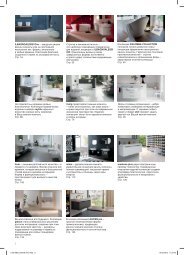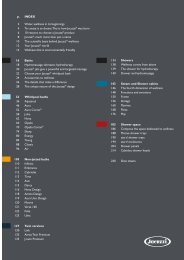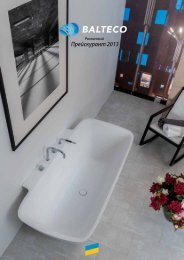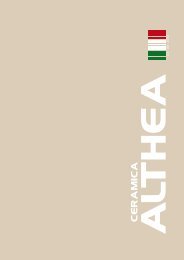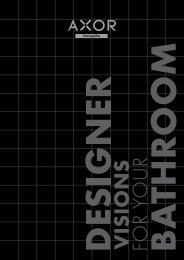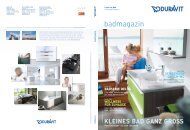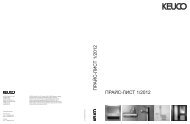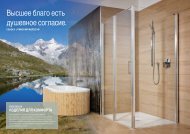You also want an ePaper? Increase the reach of your titles
YUMPU automatically turns print PDFs into web optimized ePapers that Google loves.
RECOMMENDATIONS FOR INSTALLATION<br />
FITTING TECHNIQUE<br />
Joints:<br />
These are the separations left between the tiles for aesthetic or functional<br />
reasons (dimensional deviations). The fitting is considered to be with a<br />
joint when the separation between tiles is equal to or over 3 mm, and<br />
without joints when this is under 3 mm (on deformable supports or any<br />
subject to possible movements the use of a joint is essential).<br />
In the event of working without joints the minimum separation advisable<br />
is 1,5 mm due to the fact that smaller separations do not prevent contact<br />
between tiles.<br />
There are various types of joints in a site:<br />
This documents considers the following types of joint-filling material:<br />
· Portland cement grout: JC<br />
This is used in interior spaces with no additional stress. it is not advised<br />
in hygienic or frequently cleaned zones.<br />
· Joint mortar: J1<br />
Ready-made mortars for joints consisting of cement, sand, synthetic<br />
resins and additives which give a greater water retention capacity. These<br />
can contain pigments. Available for fine and broad joints.<br />
Used in joint-filling on indoor wall tiles and both indoor and outdoor<br />
paving. Compatible with all kinds of tiles (not recommended in wall tiles<br />
with deformable supports, facades, areas with heavy traffic, heated floor<br />
tiling or paving, places frequently cleaned with aggressive products and<br />
ones for health and foodstuff use. The maker indicates the quantity of<br />
water to be used for mixing.<br />
· <strong>De</strong>formable joint mortar: J2<br />
Differentiated from the previous one through containing latex (can also<br />
be added to the mixing water). This additive increases the flexibility,<br />
improves the resistance to humidity and to abrasions as well as increasing<br />
adhesion in materials that do not absorb very much.<br />
> 143<br />
A. Structual Joints:<br />
These are designed to absorb movements in the building and must<br />
always be respected. They can be covered with adequate profiles and<br />
filled with the indicated materials.<br />
B. Perimeter Joints:<br />
All joints where the wall meets the floor. The minimum width will be<br />
8 mm and must be empty or filled with a deformable material. They can<br />
be concealed with the skirting board or the wall tile.<br />
C. Settin Joints:<br />
These are the spaces left between tiles. The setting will be considered to<br />
have a joint when the space between each tile is greater than or equal to<br />
3 mm. For spaces of less than 3 mm, there is considered to be no joint.<br />
There should always be a minimum gap of at least 1,5 mm.<br />
Recommended for use on facades, tiling deformable supports (such<br />
as wood) pavings with heavy traffic and areas with a high degree of<br />
humidity. Not recommended in places subject to frequent cleaning with<br />
aggressive products as well as areas for foodstuff and sanitary use.<br />
· Epoxy mortar: JR<br />
Consists of synthetic resins and an organic hardener (can also contain<br />
minerals) This product withstands chemical products and provides<br />
bacteriological resistance as well as high adherence. Stands up very well<br />
to humidity and abrasion.<br />
Recommended for use in areas with aseptic requirements, chemical<br />
resistance and humidity and abrasion.<br />
EXECUTION AND SEALING:<br />
We recommended partially filling the fitting joints with strips of<br />
compressible material (rubber and cellular plastics, as well as sheets of<br />
cork or fibres for calking) before filling these completely.<br />
This material must be recovered after compression. This should be<br />
enough to support the joint-filling material and prevent the joint from<br />
ejecting this when it tightens up.<br />
The compressible material should not adhere to the joint-filling material<br />
(if this were to occur cover with isolating tape). These tapes should allow<br />
the application of a suitable amount of joint-filling material, to a depth<br />
of at least 6 mm.<br />
COVERING LOCATION THIRD IDENTIFIER GROUNTING MATERIAL GUIDELINES<br />
Floors<br />
Walls<br />
Interior<br />
Exterior<br />
Interior<br />
A<br />
B C<br />
JC - J1 J1 - Recommended for damps areas.<br />
A J1 - J2 J2 - For areas where there is persistent water.<br />
AH, H J2 - JR JR - For food-processing and sanitary uses, or where aggressive chemicals are used.<br />
E. AE J1 - J2 J2 - In areas affected by frost or abrupt temperature changes.<br />
EH, AEH J2 - JR JR - For food-processing and sanitary uses, or where aggressive chemicals are used.<br />
JC - J1 J1 - Recommended for damps areas.<br />
H J2 - JR JR - For food-processing and sanitary uses, or where aggressive chemicals are used.<br />
Exterior E, EH J2 - JR JR - For food-processing and sanitary uses, or where aggressive chemicals are used.



